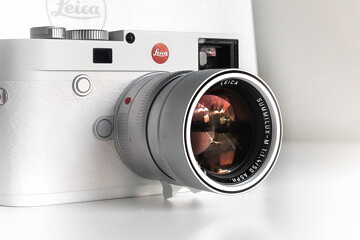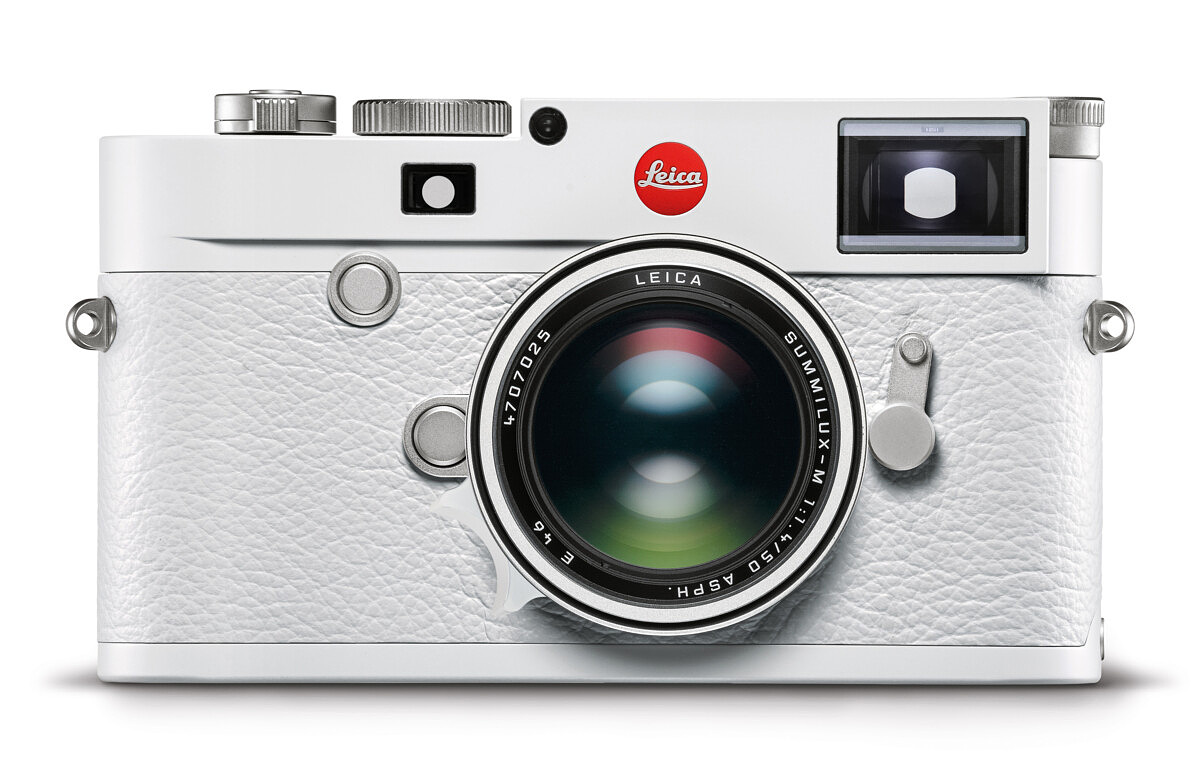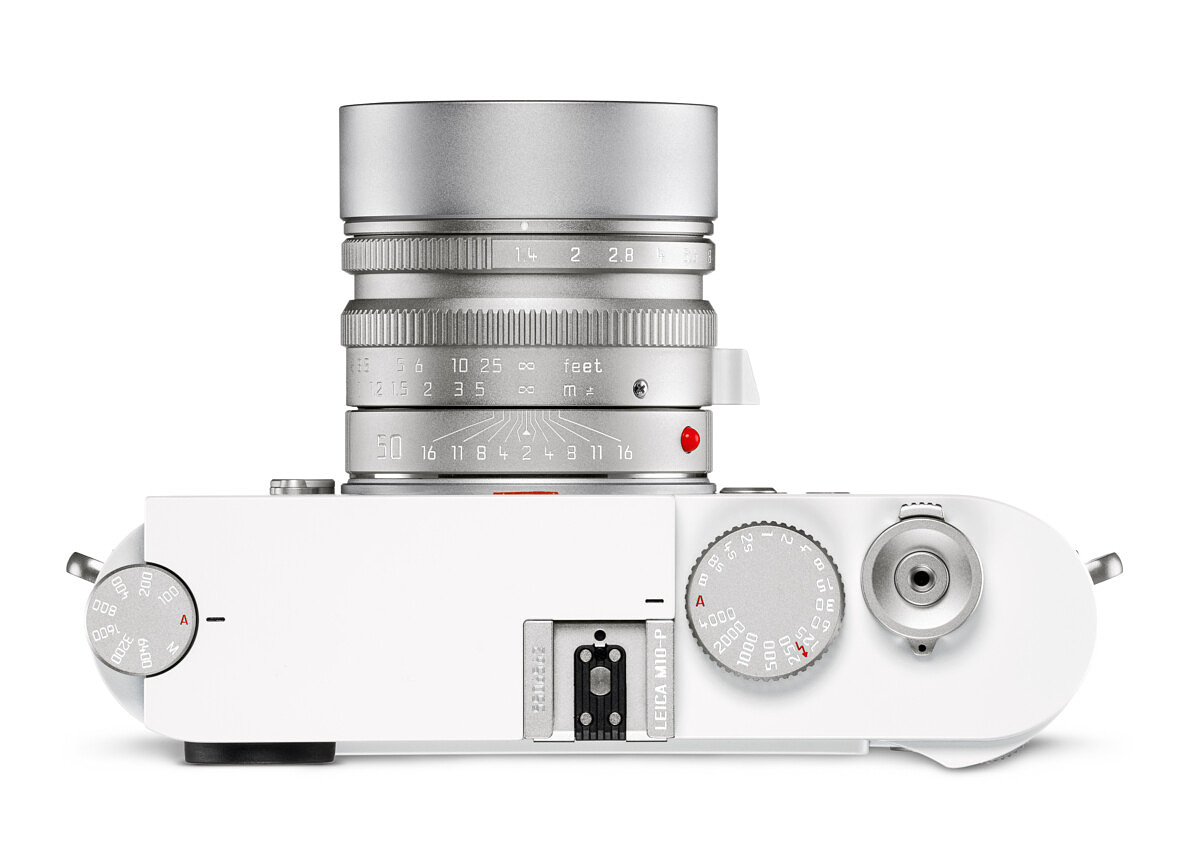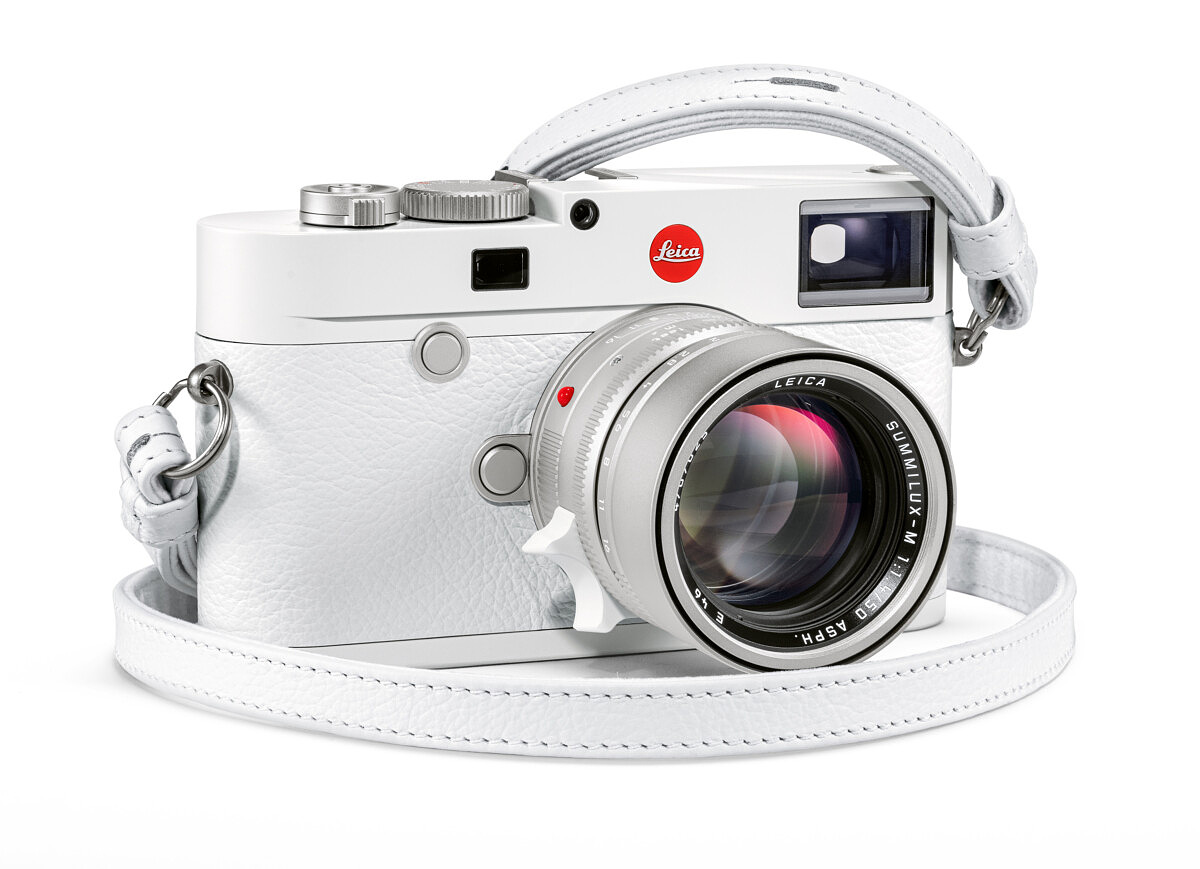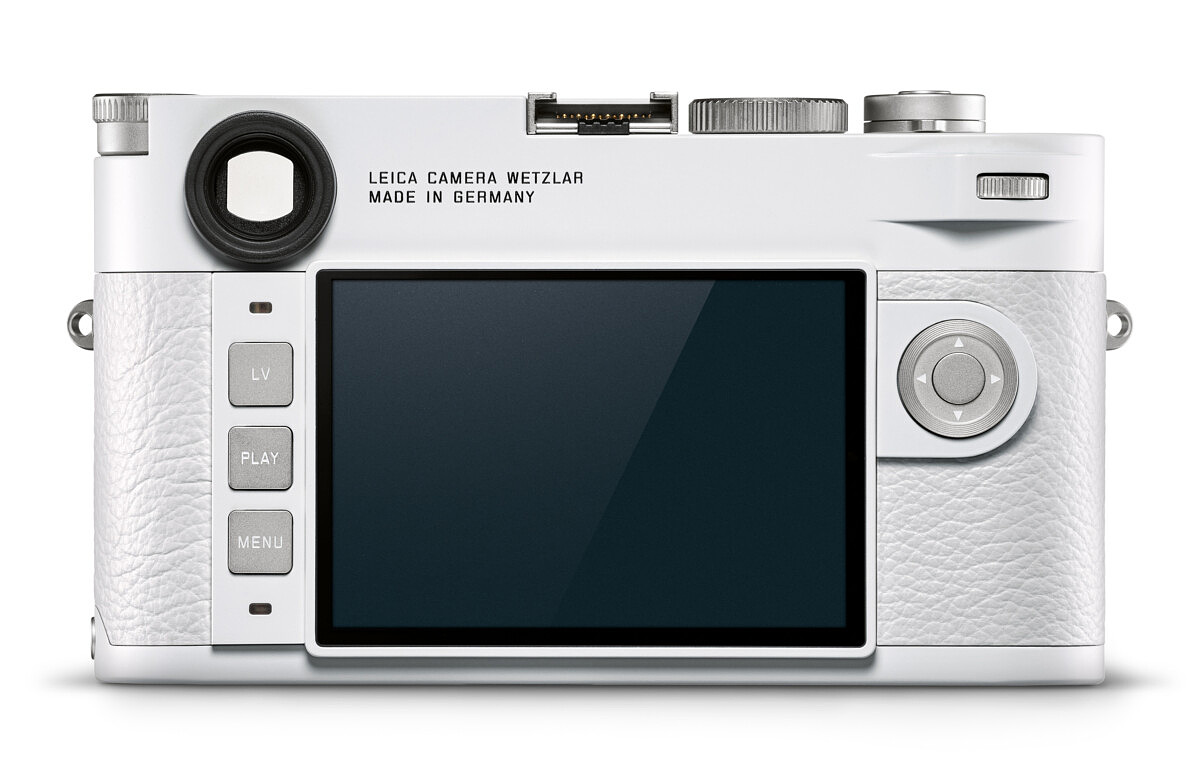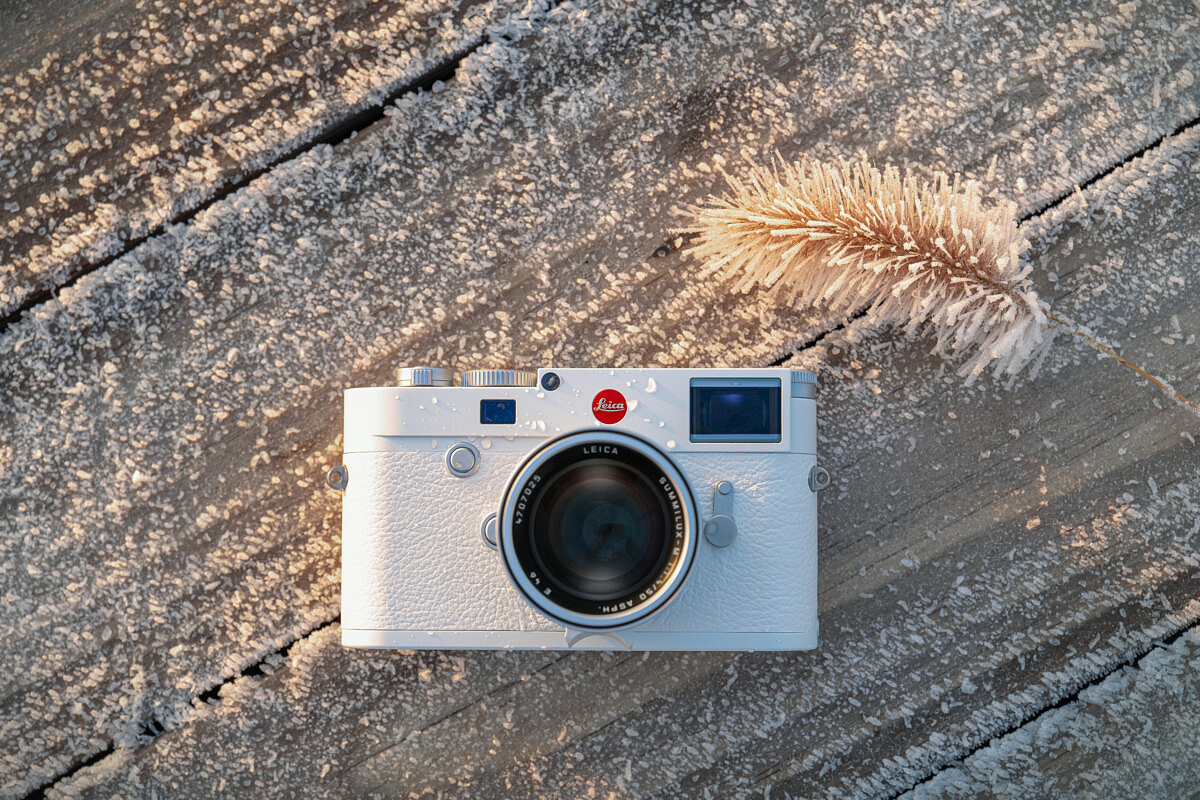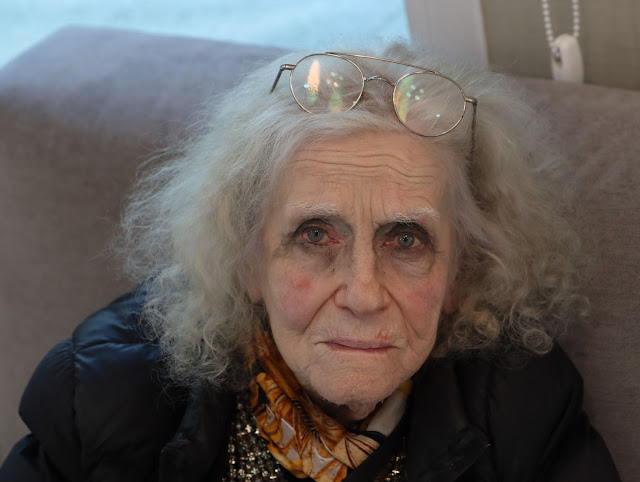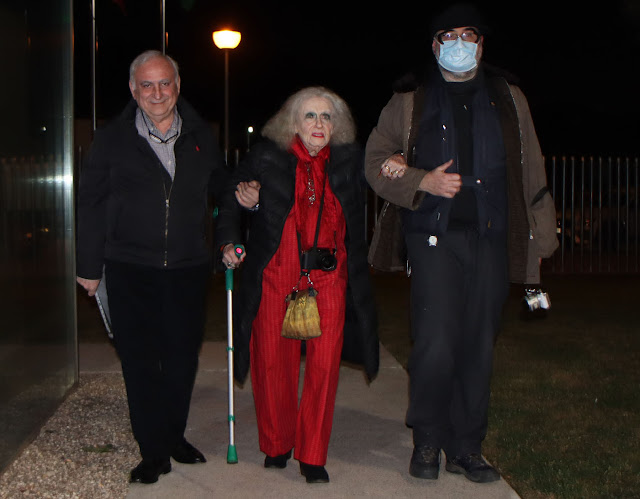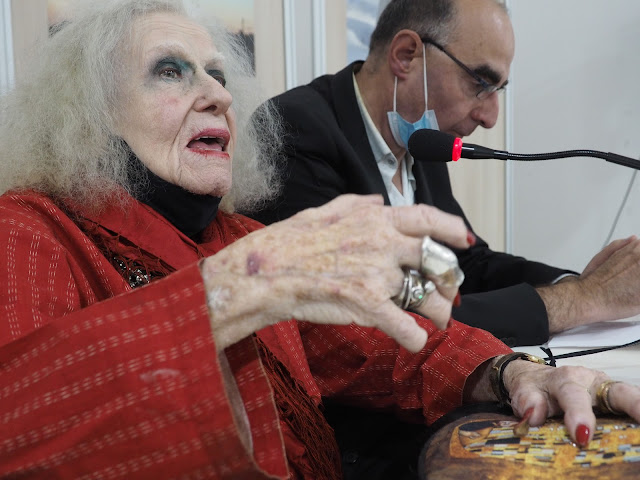Text: José Manuel Serrano Esparza
Photos: José Manuel Serrano Esparza / José Luis Caballano Alcántara / Alfonso del Barrio / Paco Flores Soler
©
jmse
8:45
a.m of December 1, 2021. Arrivals Hall 1 of Madrid-Barajas Airport.
Lisl Steiner, one of the most important and influential photographers
in history, great friend of Julia Friedmann (Robert Capa´s mother)
and Cornell Capa (Bob´s brother) has just arrived in the capital of
Spain coming from New York City in the flight DL0126 on board of a
Delta Airlines Boeing 767-300ER.
©
jmse
This
is the first layover of her almost 8,000 km travel which will take
her to Cerro Muriano (Córdoba) to attend the presentation of the
book
©
Valentín Sama
"
Robert Capa in Cerro Muriano, September 5, 1936 : Birth of the Modern
War Photojournalism ", scheduled for December 3, 2021 at 19:00
pm inside the Main Assembly Hall of the Municipal Office of Obejo
Town Hall in Cerro Muriano (Córdoba), of whose prologue she is the
author.
©
jmse
Lisl
Steiner is 94 years old and needs to use a wheelchair. She gets tired
very quickly, and in addition, she has just arrived exhausted,
because a problem with a code in the Terminal 4 of John Fitzgerald
Kennedy Airport has been on the brink of preventing her to get her
New York-Madrid plane at 7:30 a.m of the previous day.
©
jmse
Robert
Baldridge (a New York Times reporter and photographer working in
Europe, whose images have also appeared in highly prestigious
magazines like Vanity Fair,
Vogue
and others) and José Manuel Serrano Esparza, member of the Leica
Historical Society of America and author of the book " Robert
Capa in Cerro Muriano, September 5, 1936 : Birth of the Modern War
Photojournalism ", have been waiting for her since 7:30 a.m to
welcome her, and a few seconds following her arrival, after greeing
her, decide that Lisl must sit and rest, because she is worn-out and
hasn´t got any stamina to go on her wheelchair towards the taxis
area coterminous with the airport main entrance.
©
jmse
Robert
Baldridge starts shooting Lisl Steiner with his smartphone.
©
jmse
Little
by little, Lisl calms down. Her trip has been appalling, because the
two hours prior to her boarding at the New York JFK Airport were full
of stress, being about to miss her flight, though her huge courage
and perseverance made her fight tooth and nail to have every document
in time and she finally managed to get her airplane and land in
Madrid after an eight hours voyage crossing the Atlantic Ocean.
She
has only one thing in mind: she must arrive at Cerro Muriano any way,
as is revealed by her facial expression.
©
jmse
She
has come not only to pay her last homage to Robert Capa, the most
important war photographer ever (whose fire baptism took place on
September 5, 1936 in Cerro Muriano, a small village located 15 km in
the north of Córdoba City and where the modern war photojournalism
was born),
Leica
II (Model D) rangefinder camera coupled to a Leitz Elmar 50 mm f/3.5
lens with which Robert Capa made his pictures in Cerro Muriano during
the first week of September 1936. It was given away to Lisl Steiner
by Julia Friedmann (Bob´s mother) in October of 1961, two months
after her death, and sold for a price tag of 78,000 euros on November
24, 2012 at Westlicht Photographica Auction.
© jmse
but
also to her mother Julia Friedmann (of whom she was her best friend
until her demise on December 30, 1961) and his brother Cornell Capa
(with whom she likewise had a great friendship from 1960 to 2008,
year of his passing away, and in whose burial she was present, in the
same way as had happened with Robert Capa´s mother one 47 years
before).
After
resting for half an hour, Lisl Steiner is able to regain her
strength, so accompanied by José Manuel Serrano Esparza and Robert
Baldridge, all of them go to the main entrance of Madrid-Barajas
Airport Terminal 1, where they get a taxi taking them to Hotel NH
Barajas.
10:00
a.m of December 1, 2021. Lisl Steiner inside the lobby of Hotel NH
Barajas a few minutes after her arrival by taxi coming from
Madrid-Barajas Airport.
© jmse
It´s
10:00 a.m of December 1, 2021.
Top
priority at the moment is that Lisl can eat something and sleep as
many hours as possible during this December 1, 2021, because next day
we´ll have to go to Atocha Train Station to get a high speed AVE
train taking us to Córdoba City, where we will be picked up by Juan
José Obrero Castro (President of the Cerro Muriano Entrepreneurs
Association), a person who has been very important in the development
of the book project, along with the significant economical help of
the Córdoba Provincial Council and the steady support of the
Obejo-Cerro Muriano-Estación de Obejo Town Council.
©
jmse
But
once again, Lisl Steiner is dead beat. The accumulated fatigue is too
much, and above all, she needs to overcome the great anguish she
experienced the day before inside New York JFK Airport, when she was
about to miss her plane to Madrid.
Once
and again, she repeats that she has to arrive at Cerro Muriano
(Córdoa) by all means, because Cornell Capa said to her different
times before his death in 2008 that it was there where the career as
a war photographer of his brother Robert Capa (who was accompanied by
Gerda Taro) had begun.
©
jmse
Lisl
Steiner goes on being sitting on a sofa of the Hotel NH Barajas
lobby, enduring with remarkable composure the huge tireness invading
her, while she waits for the coffee she has asked.
It´s
already 10:15 a.m.
She
starts asking once and again how long will the train take from Madrid
to Córdoba,
A
24 x 36 mm format Leica II (Model D) rangefinder camera with its tiny
4 elements in 3 groups Leitz Elmar 50 mm f/3.5 lens resting on the
back cover of the 29 x 22 cm and 136 pages book. This image
epitomizes the incredibly small size and low weight for the time of
the masterpiece rangefinder cameras created by the genius Oscar
Barnack between mid twenties and 1936, a prodigy of miniaturized
engineering which meant a turning point in the history of photography
and boosted the development of a very agile photojournalism, on being
optimized to be used handheld with levels of comfort and shooting
stability unknown hitherto, since the previous medium format and
large format cameras were very big, heavy and cumbersome to use, in
addition to often requiring a tripod and longer exposure times. ©
Valentín Sama
and
insists that she must go to Cerro Muriano to attend the presentation
of the book.
We
explain her that she will spend the whole December 1, 2021 in Madrid,
resting as much as feasible, and that we´ll have to get the AVE high
speed train the following day, December 2, at 7:00 a.m, to be in
Córdoba City at 9:00 a.m.
Instants
of huge emotional intensity impossible to explain with words start to
be lived.
Lisl
Steiner begins remembering her meetings in 1960 and 1961 with Julia
Friedmann inside the small apartment that Cornell Capa and his wife
Edie Schwartz had in Manhattan (New York), where she went to have tea
every week.
Julia
Friedmann, Robert Capa´s mother, sitting beside the grave of her son
at Amawalk Cemetery (New York) after heartbrokenly weeping for some
minutes.
© Lisl Steiner
And
also the many times she took Julia Friedmann to Amawalk Cemetery, 64
km from New York City, for her to pray next to his son Robert Capa´s
grave, and how once and again she collapsed by his tomb, crying
inconsolably.
She
also reports the phone call in which two months before her death,
Julia Friedmann asked her to go to the aforementioned apartment of
Cornell Capa in New York, because she didn´t feel well and wanted to
deliver her something,

Front
view of the Leica II (Model D) coupled to an uncoated Leitz Elmar 50
mm f/3.5 lens with which Robert Capa made his two impressive
reportages in Cerro Muriano area : " Harangue in the Finca of
Villa Alicia " and " Flight of the Refugees from Cerro
Muriano village " on September 5, 1936. Its dimensions for a 24
x 36 mm full format camera are stunningly small : 133 x 67 x 33 mm
(beating in this regard the smallest current Sony Alpha 7 full frame
series professional digital cameras), which in symbiosis with the
lack of a swivelling mirror inherent to a rangefinder camera and a
gorgeous utterly mechanical horizontal travelling focal plane shutter
featuring rubberized curtains designed by Oscar Barnack generating an
exceedingly whispering and almost imperceptible noise, resulted in
unsurpassed levels of discretion during the photographic act.
© jmse
which
turned out to be the 24 x 36 mm format Leica II (Model D) rangefinder
camera with which Capa got his pictures of Cerro Muriano on September
5, 1936.
©
jmse
Lisl
Steiner after having her coffee within the lobby of Hotel NH Barajas
at 10:20 h of December 1, 2021. Apparently tired, the strenuous
effort made by this woman to be present during the presentation of
the book on Robert Capa in Cerro Muriano, war truly praiseworthy and
can bluntly be defined as heroic and something whose timeless
importance will increasingly rise as years go by.
Because
this woman is a living legend in the history of photography and one
of the most important and influential women photographers ever, with
a 63 years impressive career as a photojournalist, during which she
has photographed the most relevant personalities on earth in the
scope of arts, politics, cinema, music, the greatest jazz performers,
sport and science, like Henri Cariter-Bresson, Oscar Niemayer, Martin
Luther King, Alfred Eisenstedt, Louis Armstrong, the United States
presidents Dwight Eisenhower, John Fitzgerald Kennedy, Lyndon
Johnson, Richard Nixon, Gerald Ford, Jummy Carter and Ronald Reagan,
the Formula 1 World Champion Juan Manuel Fangio, Ray Bradbury, Pelé,
Robert Kennedy, Duke Ellington, Ingrid Bergman, Miles Davids, Leonard
Bernstein, Cornell Capa, Carmen Amaya, Adlai Stevenson, Franz
Beckenbauer, Rod Steiger, Pau Casals, Pablo Neruda, Nat King Cole,
Sir Thomas Beecham, the USA Secretary of State Henry Kissinger, Erich
Leinsdorf, Fidel Castro, B.B. King, Norman Mailer, Jorge Luis Borges,
Claire Yaffa, Friedrich Gulda and others.

©
Leica Fotografie International
On
the other hand, her images have also been published by highly
prestigious international photography magazines like Leica
World,
Leica
Fotografie International,
Black
+ White Photography,
FV
and others.
©
jmse
And
her pictures have been shown in photographic galleries all over the
world, like the New York Leica Gallery, Westlicht Vienna, the Miami
Concrete Space Gallery, the Fotogalerie Faber in Vienna, the Gallery
of the Austrian Cultural Forum in Bratislava and others.
After
spending most of December 1, 2021 sleeping and eating as much as
possible to recover energy, Lisl Steiner, Robert Baldridge and José
Manuel Serrano Esparza get up at 5:30 a.m, leave the Hotel NH Barajas
and take a taxi bound for Atocha Train Station in Madrid, where they
must meet Alfonso del Barrio (Director of FV Photography magazine,
the most important in the world written in Spanish since 1987) at
6:30 a.m.
©
jmse
Lisl
Steiner and Robert Baldridge at 6:20 a.m inside the access room to
high speed AVE train Madrid-Córdoba on December 2, 2021.
©
jmse
Another
image of Lisl Steiner with Robert Baldridge while both of them wait
with José Manuel Serrano Esparza for the arrival of Alfonso del
Bario, to travel from Madrid to Córdoba within the 7:00 a.m AVE high
speed train.
©
jmse
8:10
a.m of December 2, 2021.
Robert
Baldridge, Alfonso del Barrio, José Manuel Serrano Esparza and Lisl
Steiner inside the Madrid-Córdoba high speed train while crossing
Ciudad Real province.
©
jmse
9:00
a.m of December 2, 2021. Another image of Robert Baldridge, Alfonso
del Barrio and Lisl Steiner within the Madrid-Córdoba high speed AVE
train, which has just arrived in Córdoba City.
©
jmse
9:01
a.m of December 2, 2021. Lisl Steiner, Robert Baldridge, Alfonso del
Barrio and José Manuel Serrano Esparza start to leave the AVE train
to set foot on Córdoba City.
©
jmse
The
narrowness of the AVE train central corridor compels Lisl to do an outstanding effort to be able to walk up to the exit door, because
nobody can laterally grab one of her arms during those instants, to
such an extent that Alfonso del Barrio holds her from behind to avoid
a possible fall.
©
jmse
Lisl
Steiner, Alfonso del Barrio and Robert Baldridge posing on the
platform of the high speed AVE train in Córdoba City, after getting
off it.
©
jmse
Lisl
Steiner, Alfonso del Barrio and Robert Baldridge walk across the
platform towards the elevator climbing to the adjacent street to the
Córdoba AVE Train Station, while Robert Baldridge accompanies Lisl
Steiner, who is being taken in a wheelchair by a service woman of the
RENFE (Spanish National Network of Railways) Assistance Service.
©
jmse
After
being picked up by Juan José Obrero Castro (President of the Cerro
Muriano Entrepreneurs Association) beside the main door of Córdoba
AVE Train Station, Lisl Steiner, José Manuel Serrano Esparza, Robert
Baldridge and Alfonso del Barrio head for Cerro Muriano, 15 km in the
north of Córdoba City.
Lisl
Steiner spends the whole December 2, 2021 inside the Restaurant Bar
X, sleeping to gather strength and eating very much, since the
following day December 3, 2021 would be filled with strong emotions.
The
announcing advertisement of the book presentation had been put in the
web page of the Obejo-Cerro Muriano-Estación de Obejo Town Council
one week before the event, along with the main activities inherent to
the Festivities of Santa Bárbara, Patron of Cerro Muriano, and also
in other online and paper media, which had brought about an
oustanding expectation.
Outer
façade of the Municipal Office of the Obejo Town Council in Cerro
Muriano (Córdoba), whose Assembly Hall would hold the book
presentation.
© jmse
But
it was impossible to foresee how many people would attend the event,
because December 3, 2021 was a Friday (day in which vast majority of
people devote their free time to all kind of leisure, to get rid of
the many hours of daily work), in the middle of the longest holiday
weekend of the year and during a cold evening (though the excellent
central heating of the Obejo Council Town Municipal Office in Cerro
Muriano Assembly Hall would warm everybody).
Therefore,
nobody could imagine in advance the great quantity of persons (most
of them inhabitants of Cerro Muriano village) that would attend the
event, almost filling the Assembly Hall, and which would be along
with Lisl Steiner´s presence, a key factor for the success of the
book presentation, during which a number of truly unforgettable and
magic moments would have to be lived.
©
jmse
The
92 books had already been inside the Assembly Hall of the Municipal
Office of Obejo Town Council in Cerro Muriano since 17:30 p.m of the
Friday December 3, 2021, a nice gesture speaking volumes about the
Córdoba Provincial Council and the Obejo Town Council in Cerro
Muriano.
©
jmse
17:45
p.m of December 3, 2021. In the image, one of the tables with books
that were given away to the attendees to the presentation inside the
Assembly Hall of the Municipal Office of Obejo Town Council in Cerro
Muriano (Córdoba).
It
is a 29 x 22 cm and 236 pages work stemming from 26 years of
intensive research made in the place by its author, the photo
historian José Manuel Serrano Esparza, between 1995 and 2021,
including an in-depth analysis of every and each of the images
created by Robert Capa in Cerro Muriano during the first week of
September 1936.
©
jmse
18:30
p.m of December 3, 2021. Inside one of the rooms of the Restaurant
Bar X in Cerro Muriano. Lisl Steiner is all dressed up for the
occasion. There are very few minutes left for her to be taken by car
to the Assembly Hall of the Obejo Town Council in Cerro Muriano to
attend the book presentation and pay her respects to Cerro Muriano
inhabitants, something she has been emphasizing since her arrival in
Spain two days before.
Moments
of unutterable passion, irrepressible emotions and unforgettable
anecdotes are approaching, to such an extent that this book
presentation will go far beyond the photographic and historical
aspects of the event, thanks to the stratospherica human dimension of
this Great Dame, whose presence in Cerro Muriano is a real treat.
©
jmse
18:45
p.m of December 3, 2021. Lisl Steiner arrives at the Municipal Office
of the Obejo Town Council in Cerro Muriano (Córdoba), being helped
by Juan José Obfero Castro (President of the Cerro Muriano
Entrepreneurs Association) and Alfonso del Barrio (Director of FV
photography magazine), while Robert Baldridge walks beside them.
©
jmse
Lisl
Steiner crosses the access door, helped by Juan José Obrero Castro
and Alfonso del Barrio, while Robert Baldridge documents the scene.
©
jmse
Lisl
Steiner keeps on trudging along, helped by Juan José Obrero Castro
and Alfonso del Barrio, while Robert Baldridge photographs them.
©
jmse
The
three are now very near the access door of the Assembly Hall.
©
jmse
Instant
in which Alfonso del Barrio (Director of FV photography magazine)
enters the Assembly Hall taking Lisl Steiner in her arm, while Robert
Baldridge captures the historical moment.
©
jmse
Another
image of Lisl Steiner´s entrance within the Assembly Hall, helped by
Alfonso del Barrio. You can see the highly touched countenance of 90
years old man Rafael Centeno Cobos, one of the very few persons still
alive who fled Cerro Muriano on September 5, 1936, 85 years ago, who
is remembering now the very hard journey he lived that day . He does
know that now, Julia Friedman´s best friend, to whom Robert Capa´s
mother gave away in October of 1961,

Back
top view of the Leica II (Model D) with which Capa made his pictures
in Cerro Muriano during the first week of September 5, 1936. The back
of the Leica II (Model D) number 90023 has the plug in the back
typical in the earliest Leica II cameras. It had originally been
created to be used with the Leica 1 Model A (introduction year 1925),
Compur Leica (introduction year 1926) and Leica 1 Model C first
version (introduction year 1930), all of them being non standardized
models, in such a way that a skilful employee in Wetzlar could put
the correct back focus through a hole in the plate enabling the use
of a screwdriver from inside the camera, until 1931, year in which
the back focus distance was standardized. There are hints indicating
that a high percentage of the earliest Leica II (Model D) cameras
made during 1932 were built by the Leitz factory in Wetzlar using
remaining bodies featuring the plugged hole on the back coming from
both the second half of twenties when Leicas had not interchangeable
lenses and also from the period of birth of interchangeable lenses
with the Leica 1 Model C Non Standard Mount from 1930-1931, in which
lenses were matched to individual cameras as the lens mount flange to
film distance varied with each camera, which was individually
adjusted for infinity focus, while each lens had to be matched and
adjusted for each body.
the
Leica II (Model D) camera with which his son made the pictures in
Cerro Muriano.
©
jmse
Mr
Rafael Centeno Cobos was only four years and a half that day, but he
remembers with great accuracy everything which happened and the
terrible trek of many kilometers under a scorching sun that they had
to do.
©
jmse
Lisl
Steiner, aided by Alfonso del Barrio, supported with massive bursting
into applause by the abundant attendees, approaches to the speakers
table during the presentation of the book " Robert Capa in Cerro
Muriano, September 5, 1936 : Birth of the Modern War Journalism ",
written by José Manuel Serrano Esparza.
Everybody
expresses his/her most sincere love and recognition to Lisl Steiner,
a 94 year old woman who has made a huge effort and has been eight
hours within a New York-Madrid aircraft and two further hours inside
a Madrid-Córdoba high speed AVE train, that´s to say, a trip of
8,000 km and twelve hours, to be in Cerro Muriano.
 ©
jmse
©
jmsePartial
view of the Assembly Hall of the Municipal Office of Obejo Town
Council in Cerro Muriano.
The
emotional intensity starts exponentially to rise up, because Susy
Gómez (librarian of the Obejo-Cerro Muriano-Obejo Train Station Town
Council), with wise criterion, has put the oldest inhabitants of
Cerro Muriano village in the first row,
It
is a highly representative area, occupied by living legends in the
history of Cerro Muriano like Rafael Obrero Jurado (son of the
mythical Encarnación Jurado and author of the endearing book "
Morriones, 1938 : Esfuerzo y Tesón en Cerro Muriano " ), Manuel
Gómez Parra (a legendary miner, number one together with the also
well-known Mr Caracoles of the Cerro Vértice fluorite mine, the
reference-class one in terms of fluorspar quality throughout
seventies and eighties, who was congratulated some months ago by his
great level as a miner by Stuart Wilensky, the most important
collector of minerals in the world and owner of a big shop in New
York), Tere de los Ríos (an exceedingly beloved person in Cerro
Muriano, featuring a great heart and the famous charm of Cordoban
women), Antonia Loaisa Blanque (Queen of Cerro Muriano, the kindness
itself and who lived the Spanish Civil War when she was a little
girl), Lola Domene Corral (daughter of Silveria Corral Loaisa),
Rafael Centeno Cobos (who went away on foot with his parents and
brothers on September 5, 1936 and thirty-three years later, in 1959,
met Herminia López Romero, his lifetime illuminating beacon),
Engracia García (who put the first chemist´s in Cerro Muriano) and
Juan Antonio Caler (an alchemist of masonry and the diachronic
reference-class man of Cerro Muriano in this realm along with the
unforgettable Antonio Sastre Candelario and Manuel Zoilo).
It
was also very present the remembrance of Antonio Martín Cabanillas
(1911-2010), a highly respected and yearned person in the village,
who had to fight as a combatant during the Spanish Civil War,
subsequently becoming one of the most legendary characters in Cerro
Muriano history.
Besides,
the event was also attended by Juan Manuel Fernández Delgado
(Commercial Director of Mercedes-Benz Covisa Córdoba, a great
enthusiast of classic black and white photography and currently one
of the most important collectors in Spain regarding this field),
Alfonso Cuadro Romero (son of the illustrious railman of the Obejo
Train Station Pedro Cuadro Calvente, who couldn´t attend because of
illness), Patricio Hidalgo Luque (top world expert on military topics
related to the Spanish Civil War in Córdoba) and José Luis
Caballano Alcántara (President of the Industrial Organization
Professional Association of Engineers in Spain).
©
José Luis Caballano Alcántara
Speakers
table within the Assembly Hall, a few seconds before the beginning of
the book presentation.
Standing
up, from left to right : Adela Romero Blanque (Culture Town
Councillor of the Obejo-Cerro Muriano-Estación de Obejo Town
Council), Ramón Hernández Lucena (Delegate Deputy of Democratic
Memory and Cooperation to Development in Córdoba), Pedro López
Molero (Mayor of Obejo-Cerro Muriano-Estación de Obejo Town
Council), Juan José Obrero Castro (President of Cerro Muriano
Entrepreneurs Association). Sitting : Lisl Steiner (international
photographer) and José Manue Serrano Esparza (photo historian,
member of the Leica Historical Society of America and author of the
book).
©
José Luis Caballano Alcántara
Another
image of the speakers table inside the Assembly Hall, a few minutes
before the book presentation. Standing up, from left to right :
Higinio Gálvez Capitán (a great expert on digital technology and
all kind of electronic devices, as well as having been the person who
made an excellent layout of the book), Susy Gómez (librarian of the
Municipal Library of Obejo Town Council in Cerro Muriano, a very
efficient and experienced person, sporting a great knowledge on Cerro
Muriano village and whose labour was invaluable in the organization
of the event), Juan José Obrero Castro (President of Cerro Muriano
Entrepreneurs Association), Pedro López Molero (Mayor of the
Obejo-Cerro Muriano-Estación de Obejo Town Council) and Alfonso del
Barrio (Director of FV photoraphy magazine). Sitting: Adela Romero
Blanque (Culture Councillor of the Obejo-Cerro Muriano-Estación de
Obejo Town Hall), Lisl Steiner (international photographer) and José
Manuel Serrano Esparza (photo historian, member of the Leica
Historical Society of America and author of the book).

©
Paco Flores Soler
Alfonso
del Barrio (Director of FV photography magazine) during his speech in
which he highlighted the importance of this book, fruit of 26 years
of toil, the huge photographic dimension of Robert Capa being still
utterly present and the huge significance of the images he made in
Cerro Muriano, which meant to practical effect his fire baptism as a
war photojournalist, and the landmark presence of Lisl Steiner during
the book presentation.
©
José Luis Caballano Alcántara
Ramón
Hernández Lucena (Delegate Deputy of Democratic Memory and
Cooperation to Development of Córdoba) perusing with Juan José
Obrero Castro (President of the Cerro Muriano Entrepreneurs
Association) some pages of the book " Robert Capa in Cerro
Muriano, September 5, 1936 : Birth of the Modern War Photojournalism
" written by José Manuel Serrano Esparza.
The
speech pronounced by Ramón Hernández Lucena was another of the most
important aspects of the day, insisting on the timeless relevance of
Robert Capa figure in the History of Photography, and also on the
endeavour made by the Delegation of Democratic Memory of the Córdoba
Province Council to finance the book, a key factor to turn it into
reality.
The
deputy Ramón Hernández, visible touched, clearly perceives the
significance of this book presentation and says that among all the
books he has introduced until now, this is the one having gathered
more people, something that in his words must make very proud the
Obejo-Cerro Muriano-Estación de Obejo Town Council, its Culture
Councilorship and the Córdoba Province Government, because having
the Assembly Hall almost full a Friday at 19:00 p.m in such a cold
evening and in the middle of the longest holiday weekend of the year
is an unprecedented success.
He
also states that it is an honour to have Lisl Steiner in the event
and thanks her for the huge effort made to attend the presentation of
the book.
Ramón
Hernández Lucena explains the genesis of the Democratic Memory
Delegation, whose goal is to create grants enabling the town halls
the economic viability of studies, researches and books highlighting
events that took place during the Spanish Civil War.
Ramón
Hernández´s enthusiasm increases more and more every second as he
speaks, until reaching its top peaks on stating with remarkable
certainty and thrill that this book could be instrumental to put
Obejo, Cerro Muriano and the Obejo Train Station in the world map and
will make the area known to a lot of people from both Spain and other
countries, since Robert Capa´s images and the huge impact attained
by his labour as a war photographer were something very important
during the Spanish Civil War.

Picture
made by Julius Huisgen to Oscar Barnack inside his office at Ernst
Leitz Wetzlar in 1934. Here we can see the genius holding with his
left hand a cardboard with two 13 x 18 cm prints, each one with its
corresponding 24 x 36 mm contact, while he keeps a third print of the
same size in his right hand. The synergy between the Leica II Model D
(one of the milestone 24 x 36 mm cameras created by Oskar Barnack and
first one sporting a built-in rangefinder), the tiny Leitz Elmar 50
mm f/3.5 lens designed by Professor Max Berek and Capa´s tremendous
talent for getting pictures from very near distances going unnoticed
proved to be amazing in Cerro Muriano during the first week of
September 1936.
© Leica Camera AG
And
he finished his major speech proclaiming that the pictures made by
Capa in Cerro Muriano were an advance and meant the coming into life
of a new war photojournalism being much more agile and dynamic than
the previous one, in addition to making up an open door to get
international prestige for Cerro Muriano, Obejo and the Obejo Train
Station.
©
José Luis Caballano Alcántara
On
his turn, Pedro López Molero (Mayor of Obejo-Cerro Muriano-Obejo
Station and likewise another key person to turn the book project into
a reality, supporting it from scratch) also underscored the
importance of Robert Capa as a war photographer and particularly his
huge importance in the history of Cerro Muriano.
©
José Luis Caballano Alcántara
Adela
Romero Blanque during her address. The Obejo-Cerro Muriano-Estación
de Obejo Culture Councillor, a highly cherished person in the
village, which she knows deeply, elaborated on the bet for culture
that has always been a hallmark of the Town Council and also
underlined the awesome relevance of the pictures made by Robert Capa
in Cerro Muriano on September 5, 1936 and the birth in it of the
modern war photojournalism.
©
jmse
Partial
view of the Assembly Hall of the Obejo Town Council in Cerro Muriano,
which had a great attendance of people and was almost filled up.
©
José Luis Caballano Alcántara
Juan
José Obrero Castro during his speech. The efficient work and
tenacity of the Cerro Muriano Association of Entrepreneurs President,
a great lover of his village, was fundamental for the fulfilment of
the book project.
He
explained how the book project started its path one year and a half
ago when Juan Manuel Fernández Delgado sent him an article written
by José Manuel Serrano Esparza and published by FV photography
magazine including some photographs made by Capa in Las Malagueñas
hill with a Leica II (Model D) and Alfonso del Barrio sent him
different FV magazines where a number of José Manuel Serrano
Esparza´s articles on the pictures created by Capa in Cerro Muriano
on September 5, 1936 had been published.
He
quickly made contact with José Manuel Serrano Esparza, began to see
what could be done with all of that information, the Battle of Cerro
Muriano, many new photographs, and so forth.
He
emphasized that the images captured by Capa in Cerro Muriano tell a
very important story, so he started looking for funding to pay the
pictures rights, a first-rate printing house to manufacture the books
in a handcrafted way, etc. There was a meeting with Pedro López
Molero (Mayor of the Obejo-Cerro Muriano-Estación de Obejo Town
Council), which took a lot of interest in the project and thought how
to ask for a grant, which was finally bestowed by the Córdoba
Provincial Council.
He
had to become managing director of the book project, to be able to
make the necessary arrangements with the Córdoba Provincial Council
and the Obejo-Cerro Muriano-Estación de Obejo Town Council.
On
the other hand, Juan José Obrero Castro commented the great gift
displayed by Capa handling that very small and light Leica camera he
had, getting extraordinary pictures in which he masterfully captured
what each person felt at the moment.
He
likewise spoke about the experiences he had on visiting the places
where Capa made the photographs between Cerro Muriano and El Vacar,
and the unforgettable remembrances, after which he mentioned the
great empathy with people achieved by Capa and Taro with the people
they photographed.
Moreover,
he expressed his conviction that there are perhaps living people who
were photographed by Capa and don´t know it, so the pictures
appearing in this book could be very useful to find them.
Subsequently,
Juan José Obrero Castro thanked Lisl Steiner for her visit, and
explained that from her arrival at Cerro Muriano on December 2, 2021,
Lisl had been asking if her visit would be good for Cerro Muriano,
because that would be her greatest wish, as well as supporting the
book presentation.
©
José Luis Caballano Alcántara
Lisl
Steiner with José Manuel Serrano Esparza, author of the book (who
has published a raft of articles on pictures made by her, both in
Spanish and foreign ones), with whom she had had a great and sincere
friendship for nine years.
©
jmse
Higinio
Gálvez Capitán handling the images projection with his laptop. You
can see the great quantity of attending audience who almost filled
the large Assembly Hall.
©
jmse
Lisl
Steiner on her seat at the speakers table, with her 24 x 36 mm format
Leica Q digital camera coupled to a Summilux 28 mm f/1.7 ASPH lens
that was given away to her by Andreas Kaufmann (CEO of Leica Camera
AG) in 2019.
©
jmse
Partial
view of the Assembly Hall while Robert Baldridge beholds a just
captured image.
©
Alfonso del Barrio
José
Manuel Serrano Esparza, author of the book, during his speech in
which he highlighted Robert Capa´s figure not only as an immensely
talented war photojournalist but also as an unflinching defender of
the photographers regarding the pictures made by them.
Furthermore,
he went into detail about the key role played by
Cornell
Capa´s grave at Amawalk Cemetery (New York). © jmse
Cornell Capa (Robert
Capa´s brother)
Edie
Schwartz´s grave at Amawalk Cemetery (New York). © jmse
and his wife Edie Schwartz, whose indefatigable
search made possible to preserve new pictures that appeared between
2008 and 2021, so the situation has taken a complete turnabout, in
such a way that Cerro Muriano has presently become the most imporant
place in the world to understand the birth of Robert Capa as a war
photographer and his subsequent evolution.
©
jmse
Lisl
Steiner holding the book between her hands. Almost ninety years
separate the analogue Leica II (Model D) manufactured in Wetzlar
(Germany) in 1932 with which Capa got his pictures in Cerro Muriano
from the 24 x 36 mm format Leica Q digital camera that Lisl Steiner
has on the table and which was given away to her by Andreas Kaufmann
(CEO of Leica Camera AG).
©
Alfonso del Barrio
Lisl
Steiner during a moment of her speech in which she mentioned her
great friendship with Capa family in New York, specially with Julia
Friedmann (Robert Capa´s mother), Cornell Capa (Bob´s borther) and
his wife Edie Schwartz.
She
also underscored the difficulty to create iconic images that has
nowadays brought about the culture of everything very fast and
running, in spite of the impressive technological breakthroughs of
the photographic industry and the launching into market of
professional digital cameras in different formats thay yield
exceptional image quality, with formidable capabilities that were a
dream a dream only twenty years ago.
SIGNATURE
OF BOOKS
©
jmse
Robert
Baldridge (New York Times) showing one of the images he captured with
his smartphone and in which can be seen one of the long queues made
up for the signature of books by José Manuel Serrano Esparza (author
of the book) and Lisl Steiner (author of the prologue). © jmse
After
the end of the book presentation, which took place between 19:00 h
and 20:00 h of December 3, 2021, most people waited standing up in
long queues for the signature of books by both Lisl Steiner (author
of the prologue) and José Manuel Serrano Esparza (author of the
book).
©
Alfonso del Barrio
Lisl
Steiner signing copies of the book " Robert Capa in Cerro
Muriano, September 5, 1936 : Birth of Modern War Photojournalism ",
written by José Manuel Serrano Esparza and of whose prologue she is
the author.
©
Alfonso del Barrio
Another
of the most moving and impressive instants of the day : Robert
Baldridge shows the moment in which Rafael Centeno Cobos has just
received his book, and on watching the cover goes into deep
introspection, remembering the September 5, 1936 day, when being only
four years and a half old, was forced to flee from Cerro Muriano with
his parents and siblings. It is one of the very few still alive
survivors of that historical day in which modern war photojournalism
was born in this small village being 15 km in the north of Córdoba
City.
Lisl Steiner at Amawalk Cemetery (New York) in 2013, getting pictures of the graves of Robert Capa, Julia Capa, Cornell Capa and Edie Capa. © jmse
´
To be a good photojournalist you must love human beings ´. Gisèle
Freund
´
Seeing is not enough, you must feel what you are photographing ´ .
André Kertesz
For other articles on this blog please click on Blog Archive in the column to the right
To comment or to read comments please scroll past the ads below.
All ads present items of interest to Leica owners.
_______________________________________________________________________
EDDYCAM - the first and only ergonomic elk-skin camera strap
Please make payment via PayPal to GMP Photography
Click on image to enlarge
Please make payment via PayPal to GMP Photography
Click on image to enlarge
Please make payment via PayPal to GMP Photography
